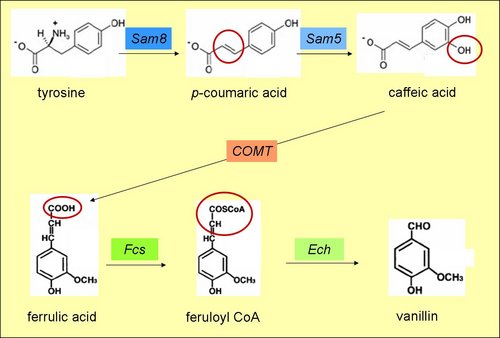Team:KULeuven/Wetlab/Vanillin Production
From 2009.igem.org
Vanillin Production: Planning
Goal
Making vanillin from tyrosine in a five-step pathway, implement a key lock function and add the LVA tag on the Sam8 and ComT enzymes.
Required
Biobricks:
- SAM8: : coding sequence without RBS
- SAM5: : RBS site + PstI restriction site removed
- COMT: : coding sequence without RBS
- LVA tag (AANDENYALAA) attached to COMT (nucleotide code: gctgcaaacgacgaaaactacgctttagtagct)
- FCS: : RBS + fcs in pSB1A2
- ECH: : RBS + ech in pSB1A2
Where from
- SAM8, SAM5, COMT, FCS, ECH will be sent to us from the French Lab from the university Edinburgh
Steps
- Test the transformation of tyrosine to ferulic acid. The enzymes are put under a constitutive promoter and transcribed. Ferulic acid concentrations are then measured with HPLC
- Test the transformation of ferulic acid to vanillin. The enzymes are put under a constitutive promoter and transcribed. Ferulic acid concentrations are then measured with HPLC
- add LVA tag to ComT (and Sam8)
- If both constructs are tested and are working, they can be combined into one plasmid and again tested.
- Then, the locks need to be added.
The experimental setup for transformation by both biobrick constructs
Electrocompetent Top10 cells were electroporated with and , additionally for blanc measurement cultures with and were electroporated. These cells were plated out on agar plates with the correct AntiBiotic and grown overnight (37°C). From these, a 5ml liquid culture supplied with AB was prepared and also grown overnight at 37°C. Subsequently 1:100th was transfered to a new liquid culture containing AB and tyrosine (5mg/L or 50 mg/L) for the first 3 enzymes(Sam8, Sam5 and ComT, ), Ferulic acid (5mg/L or 50mg/L) for the second 2 enzymes (ech and fcs, ) And vanillin (5mg/L or 50 mg/L) to determine the degradation or transformation of vanillin by E.Coli. After certain time intervals ranging between 30 minutes and many hours samples (1-5ml) were taken and centrifuged at 13000RPM for 1 minute. The supernatant was then transfered to a new tube and placed in -20°C until it was ready for analysis. Analysis was done on HPLC (High pressure liquid chromatography) using a standard LB culture for blanco and the measurements from the experiments.
 "
"








